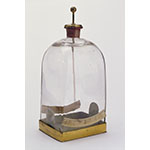Volta's straw electrometer. The two long straws are suspended to the brass rod, which terminates in a small ball at the top. A glass jar encloses the lower part of the rod and the straws, preventing them from being moved by air currents. When the conductor is not charged, the straws will align vertically because of gravity. When, instead, the ball is touched by an electrically charged body, part of the charge is diffused throughout the conductor. The straws become identically charged and repel each other, forming an angle proportional to the charge. The phenomenon is based on one of the fundamental properties of electrostatics: bodies with electrical charges of the same sign repel each other, while those with opposite electrical charges attract each other. The straws' divergence is indicated on two paper scales glued on two opposite sides of the flat-sided glass jar. Two tin foil grounding strips are in contact with the brass base.
Although Abraham Bennet's gold-leaf electroscope was more sensitive, the instrument, first described by Alessandro Volta in 1787, had the advantage of giving readings almost directly proportional to the electrical voltage being measured, provided that the straws did not diverge by more than c. 25°. Provenance: Lorraine collections.










